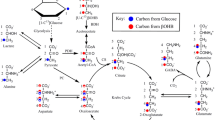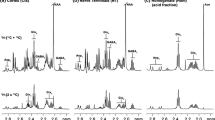Abstract
Rates of glucose andd-β-hydroxybutyrate use were determined in five brain regions of 20-day-old rats. The regions studied were cerebral cortex, thalamus, striatum, cerebellum, and brain stem. The tracers for determining rates of substrate use were [3H]fluorodeoxyglucose and [3-14C]-d-β-hydroxybutyrate. Two or five minutes after isotope administration the animals were sacrificed in a 6-kW, 2450-MHz focused microwave device. Ten minutes prior to isotope administration the animals were injected intraperitoneally with normal saline or DL-β-hydroxybutyrate (10mmol/kg). Bloodd-β-hydroxybutyrate levels averaged 0.21 μmol/ml in saline-injected and 3.13 μmol/ml in hyperketonemic rats. Rates of glucose utilization were significantly heterogeneous between regions in both groups: thalamus > cerebral cortex ⩾ striatum > brain stem > cerebellum. These rates were 20–35% lower in hyperketonemic rats. Rates ofd-β-hydroxybutyrate use varied significantly between regions only in the saline group, with the brain stem rate being significantly lower than that in cortex or cerebellum. Regional rates ofd-β-hydroxybutyrate use did not correlate significantly with regional rates of glucose use in either the saline or the hyperketonemic groups. Regional rates of glucose use were strongly and positively correlated between conditions, as were regional rates ofd-β-hydroxybutyrate use. Thus, in 20-day-old rats, the regional heterogeneity of brain glucose use is similar to that in adult rats.d-β-Hydroxybutyrate use is much less regionally heterogeneous. When brain regional rates ofd-β-hydroxybutyrate use are increased seven- to ninefold in acute hyperketonemia, there are compensatory decreases in regional rates of glucose use sufficient to keep regional rates of energy production unchanged.
Similar content being viewed by others
References
Barton, R. N. (1973). The interconversion and disposal of ketone bodies in untreated and injured post-absorptive rats.Biochem. J. 136: 531–543.
Bruning, J. L. and Kintz, B. L. (1977).Computational Handbook of Statistics, 2nd ed., Scott, Foresman, Glenview, Ill.
Corddry, D. H., Rapoport, S. I., and London, E. D. (1982). No effect of hyperketonemia on local cerebral glucose utilization in conscious rats.J. Neurochem. 38: 1637–1641.
Crane, P. D., Pardridge, W. M., Braun, L. D., and Oldendorf, W. H. (1983). Kinetics of transport and phosphorylation of 2-fluoro-2-deoxy-D-glucose in rat brain.J. Neurochem. 40: 160–167.
Cremer, J. E. (1980). Measurement of brain substrate utilization in adult and infant rats using various14C-labeled precursors. In Passonneau, J. V., Hawkins. R. A., Lust, W. D., and Welsh, F. A. (eds.),Cerebral Metabolism and Neural Function, Williams and Wilkins, Baltimore, pp. 300–308.
Cremer, J. E. (1982). Substrate utilization and brain development.J. Cereb. Blood Flow Metab. 2: 394–407.
Cremer, J. E., and Heath, D. F. (1974). The estimation of rates of utilization of glucose and ketone bodies in the brain of the suckling rat using compartmental analysis of isotopic data.Biochem. J. 142: 527–544.
Cunningham, V. J., and Cremer, J. E. (1981). A method for the simultaneous estimation of regional rates of glucose influx and phosphorylation in rat brain using radiolabeled 2-deoxyglucose.Brain Res. 221: 319–330.
Daniel, P. M., Love, E. R., Moorehouse, S. R., Pratt, O. E., Wilson, P. (1971). Factors influencing utilization of ketone-bodies by brain in normal rats and rats with ketoacidosis.Lancet 2: 637–638.
Hawkins, R. A., and Biebuyck, J. F. (1979). Ketone bodies are selectively used by brain regions.Science 205: 325–327.
Hawkins, R. A., Williamson, D. H., and Krebs, H. A. (1971). Ketone-body utilization by adult and suckling rat brainin vivo. Biochem. J.122: 13–18.
Hawkins, R. A., Hass, W. K., and Ransohoff, J. (1979). The measurement of regional brain glucose utilizationin vivo using [2-14C]glucose.Stroke 10: 690–703.
Hawkins, R. A., Mans, A. M., and Davis, D. W. (1985). Regional ketone body utilization by rat brain in starvation and diabetes.Am. J. Physiol. (in press).
Kraus, H., Schlenker, S., and Schwedesky, D. (1974). Developmental changes of cerebral ketone body utilization in human infants.Hoppe Seylers Z. Physiol. Chem. 355: 164–170.
Lowry, O. H., and Passonneau, J. V. (1972).A Flexible System of Enzymatic Analysis, Academic Press, New York, pp. 174–177.
Lowry, O. H., Rosebrough, N. J., Farr, A. L., and Randall, R. J. (1951). Protein measurement with the Folin phenol reagent.J. Biol. Chem. 193: 265–275.
Mans, A. M., Biebuyck, J. F., and Hawkins, R. A. (1981). Regional brain utilization of ketone bodies in starvation and diabetes.J. Cereb. Blood Flow Metab. 1 (Suppl. 1): S90-S91.
Medina, M. A., Deam, A. P., and Stavinoha, W. B. (1980). Inactivation of brain tissue by microwave irradiation. In Passonneau, J. V., Hawkins, R. A., Lust, W. D., and Welsh, F. A. (eds.),Cerebral Metabolism and Neural Function, Williams and Wilkins, Baltimore, pp. 56–69.
Miller, A. L. (1980). Use of [2-14C]glucose for measuring whole brain glucose utilization and its application to the study of the effects of carbon dioxide. In Passonneau, J. V., Hawkins, R. A., Lust, W. D., and Welsh, F. A. (eds.),Cerebral Metabolism and Neural Function, Williams and Wilkins, Baltimore, pp. 309–318.
Miller, A. L., and Corddry, D. H. (1981). Brain carbohydrate metabolism in developing rats during hypercapnia.J. Neurochem. 36: 1202–1210.
Miller, A. L., and Kiney, C. A. (1981). Metabolism of [14C]fluorodeoxyglucose by rat brainin vivo. Life Sci.28: 2071–2076.
Miller, A. L., Hawkins, R. A., and Veech, R. L. (1973). The mitochondrial redox state of rat brain.J. Neurochem. 20: 1393–1400.
Miller, A. L., Kiney, C. A., Corddry, D. H., and Staton, D. M. (1982a). Interactions between glucose and ketone body use by developing brain.Dev. Brain Res. 4: 443–450.
Miller, A. L., Shamban, A. T., Corddry, D. H., and Kiney, C. A. (1982b). Cerebral metabolic responses to electroconvulsive shock and their modification by hypercapnia.J. Neurochem. 38: 916–924.
Owen, O. E., Morgan, A. P., Kemp, H. G., Sullivan, J. M., Herrera, M. G., and Cahill, G. F., Jr (1967). Brain metabolism during fasting.J. Clin. Invest. 46: 1589–1595.
Persson, B., Settergren, G., and Dahlquist, G. (1972). Cerebral arterio-venous difference of acetoacetate and D-β-hydroxybutyrate in children.Acta Paediat. Scand. 61: 273–278.
Ruderman, N. B., Ross, P. S., Berger, M., and Goodman, M. N. (1974). Regulation of glucose and ketone-body metabolism in brain of anaesthetized rats.Biochem. J. 138: 1–10.
Sokoloff, L., Reivich, M., Kennedy, C., DesRosiers, M. H., Patlak, C. S., Pettigrew, K. D., Sakurada, O., and Shinohara, M. (1977). The [14C]deoxyglucose method for the measurement of local cerebral glucose utilization: Theory, procedure and normal values in the conscious and anesthetized albino rat.J. Neurochem. 28: 897–916.
Williamson, D. H., and Mellanby, J. (1974). D-(−)-3-Hydroxybutyrate. In Bergmeyer, H. U. (ed.),Methods of Enzymatic Analysis, Academic Press, New York, pp. 1836–1839.
Author information
Authors and Affiliations
Rights and permissions
About this article
Cite this article
Miller, A.L. Regional glucose andβ-Hydroxybutyrate use by developing rat brain. Metab Brain Dis 1, 53–61 (1986). https://doi.org/10.1007/BF00998477
Received:
Accepted:
Issue Date:
DOI: https://doi.org/10.1007/BF00998477




